HOSPITalk 2023 – Clinical Governance
Gethsial Kiruba1*
1Assistant Manager, Quality and Training, Kauvery Hospitals, India.
*Correspondence: corporatenursingquality@kauveryhospital.com
Background
With the objective to develop the budding young nurse leaders, HOSPItalk 2023, under the initiative of Clinical Governance, a Young Healthcare Nurse Managers Conference was organized at Conference Hall, Skill bay Academy, Trichy on 26
This was a unique initiative for motivating young nurses to take up leadership roles and so the topics for this program were carefully curated to address that.
The topics covered
in this 2 days’ programs were:
- Achieving patient satisfaction
- Effective clinical rounds
- Nursing empowerment
- Effective communication
- 5S & Lean Management in Nursing
- Creating transparent culture & Prevention of errors
- Data Analytics
- Leadership during crisis
- Working out of comfort zone
- Inventory control
- Presentation skills
- Addressing attrition
- Preceptorship program
- Doc less care more
- Adapting towards digitalization
- Emotional intelligence
- Effective time management
- Career opportunities
- Managing the team
- Employee wellness program
Effective Clinical Rounds:
Clinical rounds are like a stage drama, all the men and women who participate in that are the players.
- Hero/Heroine – Patient
- Director – Consultant
- Production Manager/Art director – Senior Nurse
- Villain – The complications
- Comedy – Make the patient happy about some thing
- Story – Clinical Status
- Script – Write partnering with the patient, Focus, Think, Identify problems, Design solutions
- What we do not want – Sound, Editing, Music, Stunt
Nursing Empowerment
Nursing Empowerment means the ability to effectively motivate and mobilize self and others to accomplish positive outcomes in nursing practice and work environment.
Nursing empowerments as a nurse are
- Initiate CPR while patient is unconscious.
- Administer 25% Dextrose for hypoglycemia
- Tepid sponging/Cold sponging to manage hyperthermia.
- Manage the pain non-pharmacologically.
- Ensure initiation of DVT prophylaxis.
- Taking blood culture before antibiotics empirically.
- BLS and ACLS provider to lead the code blue event.
- Rights to administer emergency drugs in critical situation.
- Say ‘NO’ if there are any deviations in policy Ex: Administer high alert medications in ward, Blood transfusion during night.
- Say NO to shifting patients for procedure/Surgery without consent or site Marking
- Admit the patient as per the admission criteria.
- Refuse in transferring the patient from critical ward if discharge criteria is not met.
- Perform Q2H/Q4H patient assessment in ICU, wards and escalate the care as per the nursing diagnosis.
- Shift the patient to critical care unit according to the NEWS score.
- Perform high risk assessment
- Take ECG if a patient complaints of chest pain
- Change tubes and lines as per policy
- Participate in surveillance activities in critical care areas
- Empowered to correct when wrong prescription is written
- Activate emergency code when it is required
Nursing empowerments as nurse leaders are
- To privilege their nurses based on their competencies.
- To take decision on patient care nursing, resource utilization and critical decision sometimes.
- To lead and participate in various committees.
- To conduct various mock drill.
- To participate in inventory and budgeting
- To indent for pharmacy/General Store
Effective Communication
- Elements of effective communication – Empathy, Trust, Honesty, Active listening, Validation
- Elements of Poor communication – Poor patient care, Poor choice of words, Poor organization of resources
- ISBAR – Introduction, Situate, Background, Assess, Recommend
5S & Lean Management in Nursing
- 5S – Sort, Set in order, Shine, Standardize, Sustain
- Misconceptions – 5S just before audits, Labelling is 5S, 5S is only about housekeeping & maintenance, Everyone has role in 5S, Each step to be done one by one.
- Lean Management – Process of eliminating waste and delivering value defined by the customer and creating a continuous improvement culture
- Lean improvements @ Kauvery
- Discharge process time reduced from 3hrs to 1.5hrs
- Pharmacy time reduced from 6% to 3%
- Elimination of central line associated bloodstream infection – Rs.50,000/ patient
- Case sheets – Save paper – paper reduction upto 324000 sheets
- Patient shifting time reduced from 20min to 10min only
Creating transparent culture & Prevention of errors
- Transparency is about being open and honest about matters even when things are not going well.
- Transparent culture @ workplace
- Increases employee happiness
- Better customer relationship
- Encourages better ideas
- Increases performance and clinical outcomes
- Better brand value
- Common errors @ workplace – Investigations errors, Medication errors, Communication errors, Identification errors
- Error Prevention methods
- Continuing Education Activity
- Using technology
- Proper following of IPSGs
- Risk Awareness
- Standardization of Practice
- Cultivating a Safety Culture
- Implementing Error Prevention Strategies
- Incident Reporting
- Corrective Action Preventive Action
Data Analytics
- Data are the most valuable resources for performance & outcome improvement across healthcare industries
- Sources – Right from patient registration till final billing; Health records, Medical histories, Provider notes, Mobile application & Hospital management system.
- Benefits – Improve patient care, increase efficiencies, strengthen privacy protection and adopt advanced technologies
- Data – Patient safety data, patient satisfaction/feedback data, minimum data set of patient details and Quality metrics
- Automation @ Kauvery – Daily dashboards, MIS, HMS, Automated Email alerts, Clinical Triggers, Mobile apps (Quality app) etc.
- How to identify a trigger?
- Identify an adverse event before it could occur.
- Retrospective record review
- During Clinical rounds
- Literature review
- Care provided to the patients
- Patient vital parameters
- Pharmacy purchase
- Investigation done
Working out of comfort zone
- Why? – Professional growth & development – better career aspects, Financial prospects, more exposure to outside world, upgradation to knowledge & technology, boosting the CV
- How to balance personal & professional life – Follow 5S both in home as well as work place.
- Get out of comfort zone – Take more risks, create another personality, smart work & passion towards profession, accept internal transfers.
Inventory Management
- Inventory control is to minimize the blockage of financial resources & to create space.
- Benefits includes retrieval time, space, standard re-order level, usage level monitoring, zero stock negative circumstances, reduces the delay in care.
- Vital, Essential & Desirable method of stocking, following re-order level, FIFO method of inventory management.
- If you take last item for usage, Don’t delay to Indent; Replace it immediately for next use.
Crisis Management/Managing the pandemic
- People management – COVID vs Non-COVID wards, Duty hours with required off, food & accommodation arrangements for the staff, travel arrangements of the day scholars etc.
- Resource management – Introduced pharmacy package, new equipment for managing
- Patient management – Introduction of video chat of patients with attenders, tele consultation, home care.
- Challenges faced – 1
st
wave with increased patient flow & bed management, 2
nd
wave with oxygen supply
Presentation Skills
- A presentation is a means of communication which can be adopted in various speaking situations as talking to a group, addressing a meeting or briefing a team.
- Plan, Prepare, Practice, Present
- Structure – Objective, Introduction, Main content, Summary & Conclusion and Questions
- Slides structure – Use simple fonts, use image & clipart, 3 to 7 bullet point point per slide, New or visual slides make people wake up
- Presentation skills – Data interpretation, usage of graphs, usage of pie chart, colour differentiation of data, decision making through presentation
Digital Transformation in Nursing Care
- Safer Patient World using Digitization
- Future Nursing
- Artificial Intelligence/Big data
- Automation technologies
- Smart homes technologies
- Clinical decision support system
- Electronic health records
- Mobile health
- Telehealth/Telemedicine
- Personalized/Precision healthcare
- Social media and online information
- Kauvery Initiatives – Digital ICU, Post Discharge Care, IP EMR, Life signs
Effectiveness of Preceptorship program
- Preceptorship is a period structured transition to guide and support all newly qualified practitioners from student to autonomous professional in order to develop their practice further. A preceptor is an experienced practitioner and a preceptee is a new RN/RM.
- 5 kinds of nurse preceptors
- Autocratic Style: Commanding and Imposing
- Democratic Style: Encouraging and Engaging
- Laissez-Faire Style: Detached and Easy-Going
- Bureaucratic Style: Meticulous and Precise
- Transformational Style: Inspiring and Motivating
- Benefits – Effective in increasing the nursing knowledge, supporting effective & safe care delivery by newly graduated nurses, Improves recruitment & retention.
Doc less Care more
- Documentation has been changed from paper documentation to electronic health records.
- Documentation can be minimized by
- Nursing documentation audit
- Removing unnecessarily documentation and duplication of work
- Standardization of documentation
- Awareness and training the Nurses
- Encourage use of time saving tools.
- Sustainability
- Practising Doc less will improve
- Bedside Monitoring and care
- Prevent complications
- Improve Patient education
- Nurses Skill and Competency
- Patient safety and Patient satisfaction
- Reduce the Nurses stress and improve satisfaction
Addressing Attrition
- Attrition analysis – the trend clearly indicates that, our nursing talent with a tenure of one year / less than a year experience is moving out swiftly.
- Retention strategies in pipeline
- Skip level meetings
- Counselling & Career progression
- Giving them only shadow roles
- Flexibility in allowing them to take their leaves
- Not working beyond shift timings
- Relooking at Induction – to include floor walks, initial posting in general wards in general shifts, hands on training
- Avoid asking hostellers to stay back for duty
- Handing over & taking over
- Resignation reasons – 58% toxic bosses, 54% toxic workplace, 42% stagnated career, 33% mismatch between company & personal values, 27% failure to create an impact at work, 20% better remuneration elsewhere, 19% overseas opportunity, 11% lack of remote working options, 9% more flexible time elsewhere, 6% higher academic pursuits
Time Management
- It is the ability to use one time’s effectively or productively, especially at work
- Value added activities vs Non value added activities need to be analysed to know the time spent in direct patient care, in-direct patient care, personal activities
- Effective utilization can be done using reports such as IP active patient survey, nursing audit dashboard, clinical dashboard, quality app analysis etc.
- Using time effectively includes effective planning, setting goals & objectives, setting deadlines, delegation, prioritizing activities, spending right time on the right activities, outsourcing non-clinical tasks, building a strong team and connecting with the patients.
Managing the Team
- Importance of teamwork
- Teamwork is essential for patient safety
- It minimizes adverse events caused by miscommunication
- It specifies the roles and responsibilities of each individual.
- Working in a team encourages personal growth
- Increases job satisfaction
- Reduces stress
- Reduces work load
- Helps to achieve the Vision & Mission of the Organization
- Transformation style vs Autocratic style of Leadership in team management
- Second level leader – Leadership is about developing other leaders, creating successors & creating next level roles in the organization
- Effective delegation – Transfer of responsibility for the performance of an activity or task to another person. 5 rights include Right task, Right circumstance, Right person, Right direction/communication, Right supervision/evaluation
Career Opportunities
- Developing Speciality nurses & Initiative nurses through TNNMC accredited courses and courses launched by other certified organization
- Newer opportunities -NABH assessor, NE assessor, NQAs assessor, NNF assessor, BLS/ACLS/PALS trainer
- Nursing administrative roles – Clinical Governance, Quality Head, Incharge, Supervisor, Nursing superintendent etc
- International opportunities – USA, UK, Gulf countries etc.
Patient Satisfaction
- Patient satisfaction can only be achieved by implementing the learnings from each topic such as effective clinical rounds, data analysis & decision making based on it, team management, effective communication, time management, doc less care more and so on.
- Analysing reports such as IP active patient survey for excessive pharmacy expenses & unnecessary investigations, reasons for AMA, feedback analysis.
- Solving the unsolvable issues – Addressing even the minor issues that are challengeable
Assignments
were given to the 5 teams on Identifying 2 clinical triggers and a specific topic from the modules.
- Quality App analysis
- Doc less Care more – Identifying documentation that are unnecessarily been used at the wards
- Analysis on Non value added activities
- Digitalization – Document that needs to be digitized to reduce the workload
- Time motion study to analyze the time spent on direct patient care vs other activities.
Assignments Outcome:
- Implementing antibiotic stewardship with approval of ID specialist for any higher antibiotics been prescribed.
- Digitalization – Infusions monitoring, Alerts for patient monitoring, IP EMR dilutions, Hand hygiene monitoring.
- Package – Ventilator package & Lysis package
- Pharmacy – Stock availability to be visible while indenting, Zero sock identification. Masters to be revised with available generically name. Old masters that are not existing currently to be removed.
- Blood bank – TAT time for blood issued to strictly adhered and Runner boys for blood bag issues
- Doc less Care more – reducing the listed documents- Doctors rounds register, Nurse handover, Nursing reassessment, ABCD in ER, SOAPIER, Duplication of phrases in nurse’s records etc.
- Quality app analysis – Reasons for AMA, Death & IP CC, Triage colour coding for Night admission, Transfer in & out message to consultants etc.
Clinical triggers identified by the team:
- Pantoprazole prescribed for Pediatrics
- UVC Catheter
- OAE identification
- Patient fall identification
- Hypoglycemia identification
- Urinary re-catheterization within 30 days
- Potassium level in hyperglycemic patients on infusion
- Drug induced fall identification
- Drug – Drug incompatibility
- Drug osmolality
- AVF failure
- Dialysis patient serology reconversion
- PLABSI identification
- DM patient with diabetic foot ulcer
Feedback about workshop:
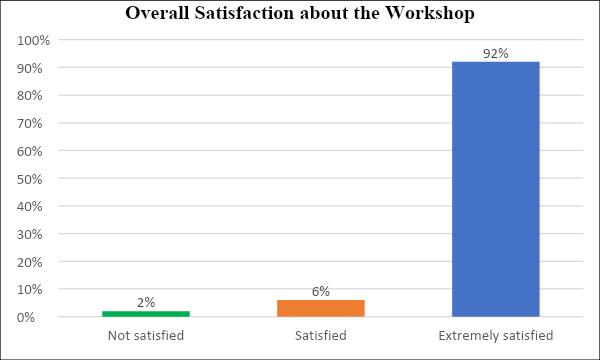
Knowledge assessment:
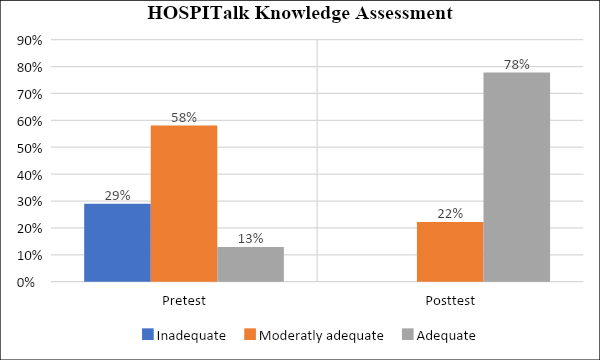
| S.No | Category Vs Scores | Inadequate | Moderately adequate | Adequate |
| <50% | 50%-75% | >75% | ||
| 1 | Pretest | 29% | 58% | 13% |
| 2 | Posttest | 0% | 22% | 78% |
Glimpse of Hospitalk 2023
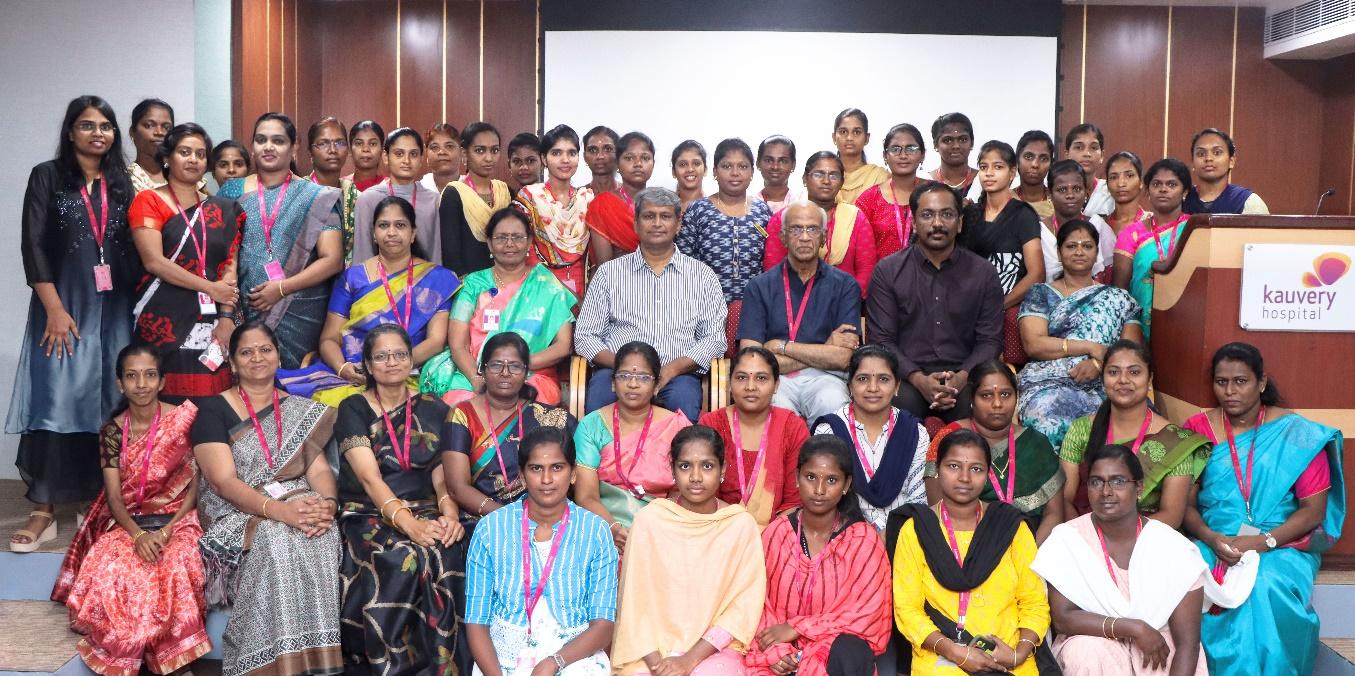
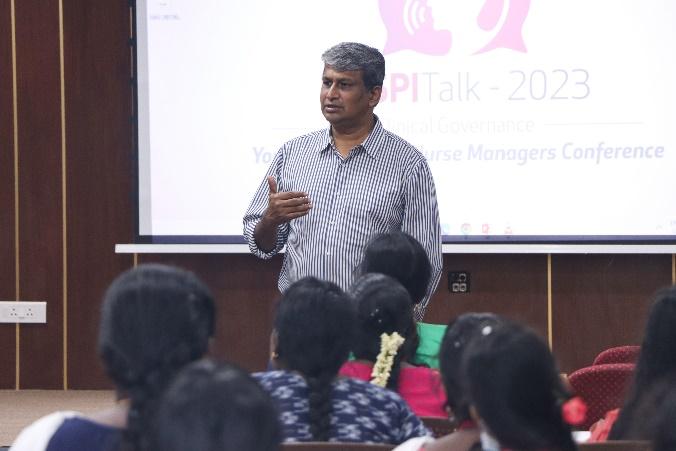
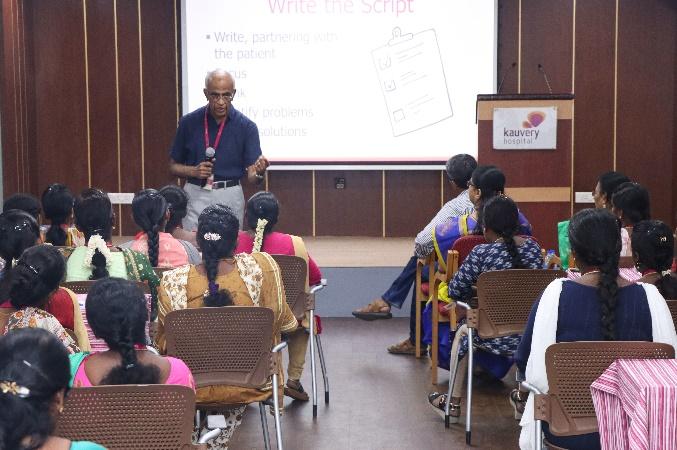
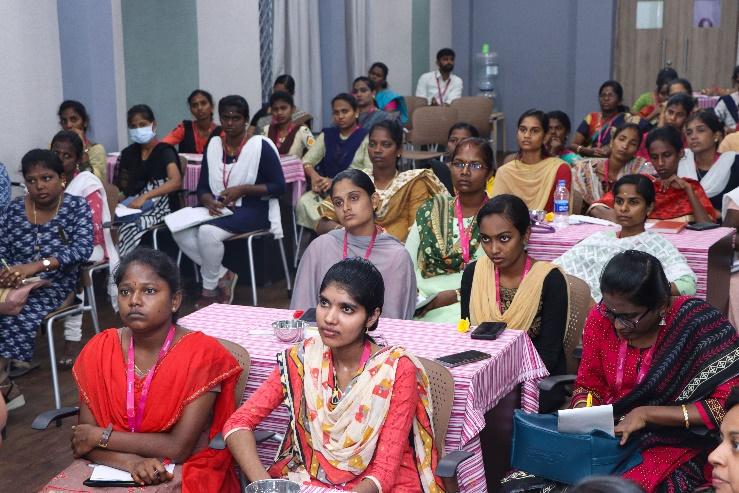
Future plans:
The Key take away points have been shared as a resource material for their future references. The selected team members shall be supported and will be practically trained for the next 3 months. They will be specifically trained in their role that they are interested and shall be utilized for inter unit audits, train the trainers, preceptorship program etc. They shall be reviewed again after 6 months.

Ms. Gethsial Kiruba,
Assistant Manager – Quality & Training

